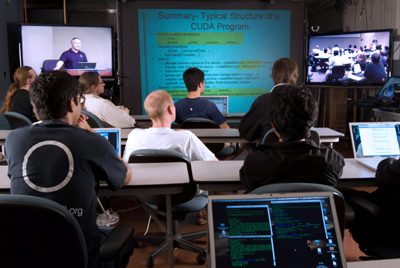High-Definition Telepresence Bridges University of Illinois Campuses for Summer School on Petascale Computing
August 18th, 2008 - August 22nd, 2008
Categories: Devices, Networking, Visualization

About
CHICAGO - The University of Illinois at Chicago is hosting a live high-definition (HD) feed of a summer school on petascale computing being taught from the National Center for Supercomputing Applications (NCSA) at the University of Illinois at Urbana-Champaign August 18-22.
Organizers of the weeklong intensive summer school, titled “Accelerators for Science and Engineering Applications: GPUs and Multicores,” received an overwhelming registration response, prompting Virtual School of Computational Science and Engineering associate director Umesh Thakkar to contact Electronic Visualization Laboratory (EVL) director Jason Leigh about holding a telepresence session at University of Illinois at Chicago.
Leigh saw this as a bigger opportunity to prototype classrooms of the future, which Leigh calls Cyber-Commons, so that Virtual School classes can ultimately be taught at more locations, whether within the region, across the nation, or around the world.
Students participating at the University of Illinois at Chicago site will hear and see the lectures and presentations on 65-inch LCD displays in EVL’s Cyber-Commons, a high-tech space outfitted with HD telepresence equipment and a 3D projection system connected via high-speed networks to a national backbone, which Dr. Leigh currently uses to teach a distributed computer game design course each year between University of Illinois at Chicago and Louisiana State University.
The Virtual School course will teach graduate students from several disciplines how to use graphics processing units (GPUs) and multicore processors to develop application software for massively parallel computing systems, such as the Blue Waters system slated to come online at NCSA in 2011.
Blue Waters is a National Science Foundation-supported initiative to build a sustained petascale computational system dedicated to open scientific research and is a joint effort of NCSA, IBM, and the Great Lakes Consortium for Petascale Computation (GLCPC).
The Great Lakes Consortium, to which University of Illinois at Chicago and the University of Illinois at Urbana-Champaign both belong, is a group of educational institutions, national laboratories and outreach organizations that are committed to cooperate on providing the most advanced educational and workforce development programs for their students, staff and faculty, in order for them to be competitive in today’s global economy. By having experts teach courses on advanced topics, regardless of where they are located, the GLCPC can help realize the full potential of petascale computing.
Leigh, a member of University of Illinois at Chicago’s computer science faculty, has been advocating a stronger emphasis in multiprocessor multicore parallel processing within the department. There is a growing trend toward parallel processing to handle the massive amounts of data used by everything from large-scale, multi-national scientific experiments, to video games.
“High-performance computing was a niche area in the past,” says Leigh. “Today, home computers and video-game systems such as the PlayStation 3 have multiple processors, each with multiple computing cores on them. In order for U.S. students to remain competitive with their foreign counterparts, they need to learn how to develop both algorithms and application codes that leverage this emerging computing capability.”
The NCSA-to-University of Illinois at Chicago HD video transmission will go over the Illinois Wired / Wireless Infrastructure for Research and Education (I-WIRE), an advanced dark fiber communications infrastructure interconnecting Argonne National Laboratory, University of Illinois at Chicago, University of Illinois at Urbana-Champaign, Illinois Institute of Technology, Northwestern University, the Illinois Century Network, and several collocation facilities in Chicago.
Persons interested in attending the EVL session should contact accelerator @ ncsa.uiuc.edu or call Umesh Thakkar at (217) 333-2095 as soon as possible, as seating availability at EVL is limited.
For more information:
www.greatlakesconsortium.org/events/GPUMulticore
About University of Illinois at Chicago, Electronic Visualization Laboratory
The Electronic Visualization Laboratory (EVL) at the University of Illinois at Chicago (UIC) is a graduate research laboratory specializing in the design and development of high-resolution visualization and virtual-reality display systems, collaboration software for use on multi-gigabit networks, and advanced networking infrastructure. It is a joint effort of UIC’s College of Engineering and School of Art and Design, and represents the oldest formal collaboration between engineering and art in the country offering graduate MS, PhD and MFA degrees. EVL has received worldwide recognition for developing the original CAVE™ and ImmersaDesk™ virtual reality systems; and, more recently, the 105-Megapixel LambdaVision tiled display and Varrier™ autostereoscopic display. EVL is a founding member of StarLight℠ the Global Lambda Integrated Facility (GLIF) and the Global Lambda Visualization Facility (GLVF), and with Calit2 / UCSD is a leading institution working on the NSF-funded OptIPuter project.
About Cyber-Commons
To provide students with better technologies in the laboratory and classroom than they currently have at home, EVL has created Cyber-Commons, a community resource openly accessible to our faculty and students, where they gather, meet, study, and work using extremely high-resolution displays connected to other locations and sites via high-speed networks. Cyber-Commons enables students to access data from global resources and to collaborate with distant colleagues using high-definition audio and video.